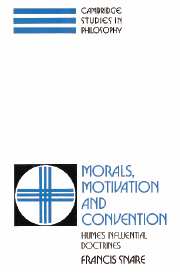Book contents
- Frontmatter
- Contents
- Acknowledgements
- NOTE
- Introduction
- Part I The argument for sentimentalism
- 1 A systematic ambiguity
- 2 The influence argument
- 3 Some bad reasons for believing the first premiss
- 4 The Humean theory of motivating reasons
- 5 The provocative Humean theory of motivation
- Part II The problems and consequences of sentimentalism
- Bibliography
- Index
5 - The provocative Humean theory of motivation
Published online by Cambridge University Press: 05 June 2012
- Frontmatter
- Contents
- Acknowledgements
- NOTE
- Introduction
- Part I The argument for sentimentalism
- 1 A systematic ambiguity
- 2 The influence argument
- 3 Some bad reasons for believing the first premiss
- 4 The Humean theory of motivating reasons
- 5 The provocative Humean theory of motivation
- Part II The problems and consequences of sentimentalism
- Bibliography
- Index
Summary
What Hume's influence argument requires as its first premiss is not just any version of Hume's theory of motivation but the ‘provocative’ version. However the preceding chapter alleged that the provocative version, conceived as a proposition conceptually true in virtue of the fundamental concepts of common sense psychology, in fact misunderstands that conceptual framework. The provocative version rules out motivational cases such as the cases 2 and 3 of the preceding chapter while common concepts of common sense psychology do not rule out these, very far from peripheral, cases. No good Humean, however, is really ever convinced by these alleged counter-examples. For a start, two ploys are commonly employed by Humeans in regard to cases 2 and 3.
THE REDESCRIPTION PLOY
One defence of the provocative version of Hume's theory is the simple redescription ploy. It consists in replacing common sense cases like 2 and 3 with superficially similar motivational cases which, then, the provocative version can handle. That version cannot handle 2 and 3 as they stand, for what individuates the provocative version from the other versions is precisely a matter of what is, or is not, to be found within the practical arguments ‘accepted’, as we would ordinarily say, in these cases. What the redescription ploy accomplishes is, not a proof of the provocative version, but a defence against putative counter-examples. It does this by offering an explanation of how it could have seemed that common sense psychology did allow cases 2 and 3.
- Type
- Chapter
- Information
- Morals, Motivation, and ConventionHume's Influential Doctrines, pp. 108 - 144Publisher: Cambridge University PressPrint publication year: 1991

